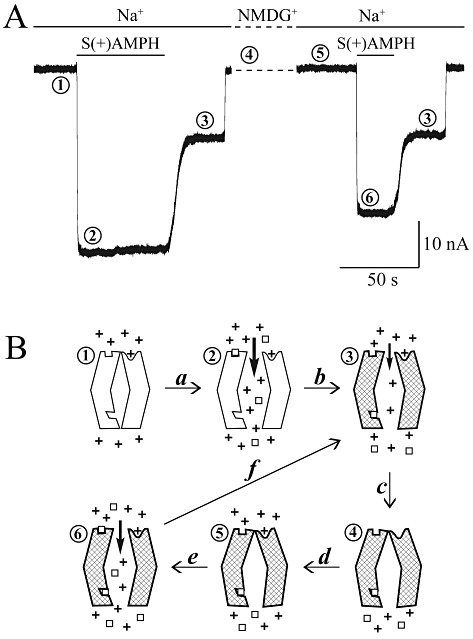Figure 5.

Model for S(+)AMPH-induced, hDAT-mediated peak and shelf currents. (A) Phase 1: the baseline current at V =−60 mV in external physiological solution containing Na+. Phase 2: the 10 µM S(+)AMPH-induced peak current in Na+, nominally between 10 and 25 nA. Phase 3: the shelf current (persistent leak current), which remains after removing external S(+)AMPH. At fixed voltage, the shelf amplitude depends on exposure time and concentration of external S(+)AMPH. Phase 4: replacing Na+ with NMDG introduces a shift in baseline that we removed from the figure (dashed line); however, re-introducing Na+ during phase 4 (phase 5) does not restore the shelf current but returns the current to the original baseline [S(+)AMPH has been transported into the cell during phase 2]. Phase 6: reintroducing external S(+)AMPH in the presence of Na+ induces a new peak current. Note that the second application of S(+)AMPH is normally too brief to elicit a shelf current; however, S(+)AMPH is already present inside the cell from the first application. The new peak is smaller than the first peak, possibly due to hDAT internalization. Finally, after removing S(+)AMPH for the second time, the shelf current again manifests itself. (B) The ‘+’ symbols stand for Na+ ions, and the ‘open squares’ stand for S(+)AMPH) or in some experiments DA. The hatched transporter indicates internal occupancy by S(+)AMPH and a long-lasting ‘molecular stent’ configuration. The numbers above each state of the transporter correspond to the traces in (A). Transition (a) opens the top and bottom gates, which for brief external S(+)AMPH exposures would close. Transition (b) occurs after longer exposures and S(+)AMPH has built up inside to the extent that the inner S(+)AMPH site remains occupied and holds both gates open (molecular stent hypothesis), even in the absence of external S(+)AMPH. Transition (c): removing external Na+ closes the outer gate, which does not reopen without external Na+ and S(+)AMPH both present (transitions d and e), rendering the transporter capable of (and indeed more prone to) forming the molecular stent (transition f), because internal S(+)AMPH is still present.
